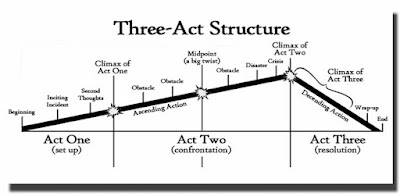The Breakout Outline with a Twist
Outlines are a necessary evil in the writing process. Sooner or later, every writer needs to use an outline to
help weave together various literary components. This is especially true if
there is a large cast of characters or a multi-layered plotline. Agents often
request outlines before seeing the full manuscript. Publishers will require
them if an option novel is proposed. There is no magic number for how many
pages an outline needs to be effective. As with everything else grounded in the
creative, it depends upon your purpose. Many long-winded outlines can be just
as useless as those not long enough.
Remember, an outline is a blueprint that reflects the
structures that will bear the weight of the story dynamics. An effective
outline illustrates the causal chain – the spine of the story. It also reflects
both the action (external) and the emotional (internal) plot movements.
I start by using this template by Donald Maass (The Breakout
Novel Workbook, 2004) because it
sharpens the focus of the narrative. Also, it works very well during the
revision process, when you outline your draft to help add texture.
What are the Key Action (External) Plot Fundamentals? (Write down the
following)
*Where is your novel set? Who is your main character, and what is his
primary conflict or goal?
*What does your protagonist’s most want and why?
*What is your protagonist’s second plot layer? What is your protagonist’s
third plot layer?
*What is the first subplot? What is the second subplot?
*Who is the most important secondary (supporting) character, what is his
primary conflict, and what does he most want?
*Who is the novel’s antagonist, what is his primary conflict or goal, and what
does he most want?
Avoid the Sagging Middle (Write down the following)
*What are the five biggest steps toward the solution of the central
conflict? In other words, what are the five turning points or events, including
the story’s climax, that take place in the narrative?
*What are the five most important steps toward, or away from, what your
protagonist most wants? These steps are consequences of choices that the
protagonist makes. This step helps identify the causal chain that creates the
plot’s spine.
*What are the three most important steps (each) toward, or away from, the
resolution of your first and second subplot?
*What are the three most important steps (each) toward, or away from, the
resolution of the plot layers?
*What are the three most important steps toward, and away from, the resolution
of each main conflict facing your secondary characters and your antagonist?
What is the Key Emotional (Internal) Plot Fundamentals (Write down the
following)
*Two moments of strong inner conflict.
*Three larger-than-life actions.
*Two moments frozen in time. (For example, Juliet laments over Romeo, as Romeo
listens below. Their first kiss erases all the wrongs of the past and ignores
all future conflicts. Another example: Eliot says good-bye to ET, and ET
responds with a gesture, saying: I’ll be right here.)
*Two measures of change.
How to Organize the Outline
You can adapt any narrative template to an outline. If you
were using the hero’s journey, for example, it would look something like
the outline below. The key to using the hero's journey is understanding what the plot points
(outlined above) represent and how they relate to the broader movements.
However, if you want something easier, try using the three-act narrative
structure. I’ve inserted the three-act structure in the outline below to
correspond to these movements so you can see how it compares.
By the way, the outline is not carved in stone. As you
organize the information, you may discover a break in the causal chain that needs
attention, or the emotional plot needs more cues. That just means
the outline is working!
(Act One) Departure
- (Set-up) The Ordinary World
- (The Inciting Incident) The Call to Adventure
- (Second Thoughts) Refusing the Call to Adventure
- Meeting the Mentor
- (Climax to Act One) Crossing the Threshold
- (Obstacles) Test, Allies, and Enemies
- (Crisis) Approach to the Inmost Cave
- (Big Twist) The Ordeal
- (Climax of Act Two) The Reward
- (Descending Action) The Road Back
- (Climax of Act Three) Resurrection
- (Wrap-up) Return with the Elixir
Next, just fill in each point by depicting that specific
pivotal moment (noted above). Don’t summarize everything: just highlight that pivotal moment
when something changes, either in the character or in the plot.
 |
| Syd Field (Screenplay: The Foundations of Screenwriting, 2005) created the three-act narrative structure for screenwriters. However, it can be easily adapted to narrative structure. |
Now get writing!
--Bobbi Miller
This is fantastic! Outlines are absolutely essential.
ReplyDeleteHi Holly! I'm glad you found it useful! I couldn't do what I need to do without an outline, that's for sure.
Delete